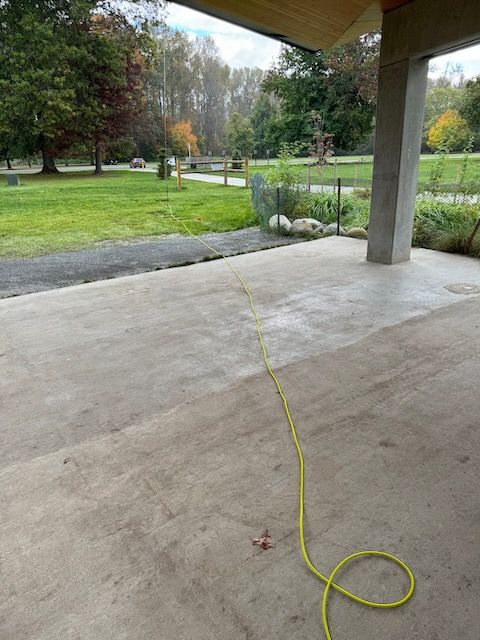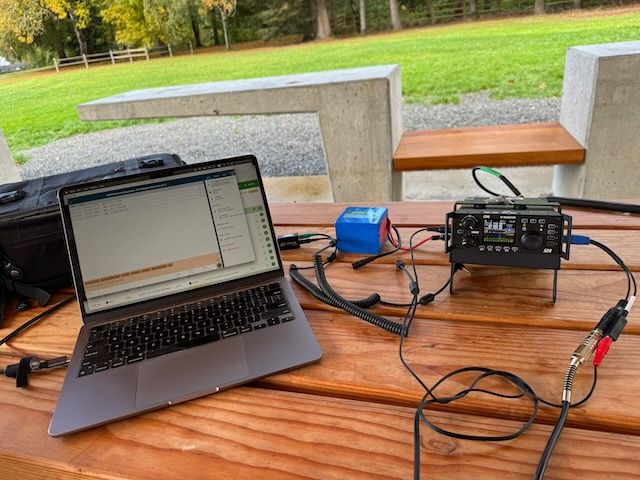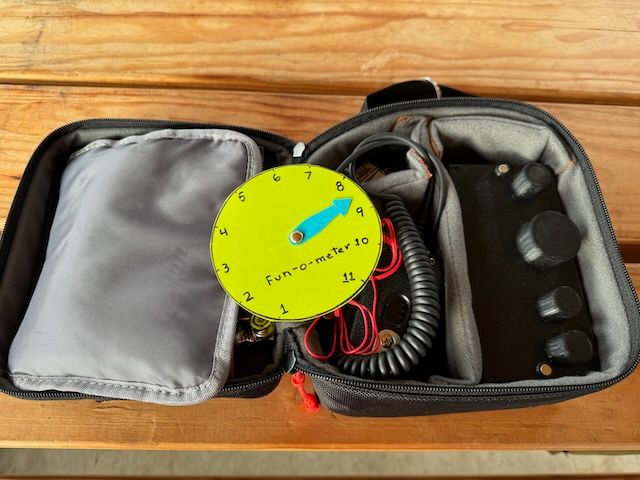Thoughts on Fun and US-3216 (Lake Sammamish SP) Activation
As we head deeper into autumn here in the PNW the weather can only get colder and rainier until spring. If I want to keep doing activations, I need to work out how to do an activation on a rainy day. My plan is to learn how to do that by doing it. So on 10/17/2024 I headed to the park, knowing in advance I was going to get rained on.
Some parks will obviously be easier than others - parks with picnic shelters, for instance, I can just set up in the shelter, put the antenna up outside the shelter with a fairly long run of coax as the feedline, and fire away. That was the plan for today, and since cell service in the park is unreliable in many locations I chose a picnic shelter just yards away from my favorite picnic table.
Because it was pretty breezy, I chose to set up on the picnic table best situated to be out of the rain, more or less centered under the shelter roof. This meant quite a distance to the ideal antenna location, because I wanted the antenna some distance away from the metal roof on the shelter. So in this case, I was mighty glad I had 50’ of armored coax to use - this is the first time I didn’t feel it was way too long.

Also, it was darn cold. Ok, perhaps not actually cold, but given my adaptation to heat from our trip to the middle east, I was very cold. More on this later.
Setup
In short order I had the MC-750 antenna up and tuned, the G90 set up, and I figured I’d give FT8 a whirl. So I had the G90 set up with the digirig, to do digital modes. After the previous kerfuffle getting the laptop to see the digirig, I had no troubles this time, except… The radio staunchly refused to transmit, and every attempt got me an error popup on the laptop. So I spent 15 minutes dorking around with the radio and the laptop before finally getting the laptop into a state where it would transmit, and even then the levels to the laptop were all screwed up, so more minutes were lost there trying to get the waterfall to look right.
FT8

Once I gave up and decided to just ignore the waterfall, I had 10 FT8 contacts in about 20 minutes, which is pretty speedy considering I spent 5 of those minutes chatting with a park ranger.
It’s not that I’m averse to digital modes. I’ve got thousands of PSK31 contacts in my log. I really enjoy PSK31. But for me, FT8 does not scratch the same itch.
SSB
With FT8 taking the pressure to get QSOs in the log off, I moved to SSB on 20m. As usual given the good conditions, finding a free frequency was a bit of a headache, and every time I found a spot I got bumped by a QRO station. Each time I got bumped, I’d hunt for a bit, and before long between calling CQ and hunting, I had another 8 QSO’s in the bag, 7 on 20m and 1 on 17m.
CW
At last, I moved to CW, first on 20m, and then when that seemed to slow down, on 15m.
It was the 15m part that surprised me. My reach on 15m with a mere 10W extended all the way to the east coast, and I snagged both FL and ME as well as Japan, a distance of 4800 miles. I was thrilled.
Even better, my CW skills continue to improve. My ability to copy callsigns is steadily improving, and assisted on occasion by the CW decode on the KX2, I was often able to respond to a caller without the usual resorting to ‘?’ to ask for repeats of the callsign.
My big weakness is sending. I need to work hard on sending fluently and without errors.
Fun Analysis
Surprisingly given the smashing success of CW on 15m, this activation was not as fun as some other recent ones have been, and I think it’s worth pondering why, as part of my ongoing effort to wring every last bit of fun there is to be had out of each activation.
Because POTA can be amazingly fun.
If I just break the activation down into the different modes I worked, that yields some useful insights.
FT8
First off, FT8 with the G90 and Digirig always seems to get me some frustration right up front, getting everything configured properly. There are clearly variables I don’t control properly. Some careful up front work on what needs to be set properly, and on working out what the settings are, would surely reduce this frustration.
And while I’m not averse to doing that work if it will eliminate frustration on the way to having fun working FT8/FT4, the larger problem is that I just don’t much enjoy FT8. Part of this is that the WSJT-X software itself is, um, rebarbative. And again, there’s other software out there, and I could use it, and maybe I’ll explore that in the future.
But the largest, unavoidable problem is that FT8/FT4 are so damn automated as an activator.
- I tell the software to call CQ POTA W7PFB, and click the ‘transmit’ button.
- Some hunter spots my CQ (or simply looks at the pota.app spotting page and repeatedly and blindly calls as if they saw a CQ), and my computer sees their response
- My computer picks one of the responses it sees, and the two stations robotically exchange signal reports and 73s.
- My computer pops up the ‘log this contact’ dialog, and I click the button to log it.
- I click the ‘transmit’ button again, so that my computer will again call CQ.
And the problem here is that while I’m working with a station that is thin hardware wise (I’m running either the G90 at 20W or the KX2 at 5w) the other half of the thin radio concept is utterly missing, as my brain is doing exactly 0% of the work. It turns out the brain bit of thin radio is exceedlingly important to my having fun. Sitting there doing nothing but occasionally clicking a button on the laptop whilst the laptop and radio churn through contacts just isn’t much fun.
I’m pretty confident that, if I were running, say, PSK31 using fldigi, I’d be having fun. But I’m not, despite the fact that PSK31 seems to me like it is nearly ideal for QRP POTA activations, because the hunter pool for PSK31 is essentially nonexistant, because hunters are all running WSJTX and chasing stations doing FT8 and FT4.
Anyway, FT8 = not fun for Paul. Other people clearly have fun, I guess they are put together differently from how I am.
SSB Phone
In contrast, SSB phone is a fair bit of fun, because at least the way I conduct activations, the pace is pretty relaxed. From my 800 or so hunter QSOs, I know there are activators whose QSOs are an example of clipped efficiency, responding to callers with “Whisky Seven Papa Foxtrot Bravo, 59 Charlie Alpha”.
That’s not me.
Mine are more “Alpha Lima Seven Kilo Charlie, Mike, it’s great to hear your voice this afternoon. You’re 57, 57 into US-3216 Lake Sammamish State Park in Washington state, are you at your home station?” And instead of an efficient “73, QRZ?” I’m far more likely to close with something along the lines of “Thanks so much for hunting today, I really appreciate it. I hope you enjoy the good weather there, 73, don’t forget to smile and have fun!” and then listen for a response to that before calling CQ again.
I’m not knocking the super efficient operators, here. They get to do their activations the way they want. My point is doing it my way is more fun for me, and by my observation it’s more fun for the hunters as well. And I think fun is a good thing.
The downside to SSB is that working from the NW corner of the Pacific Northwest part of the USA, QRP SSB is not the ideal mode. 50W is, I suspect, a different story. Maybe what that means is that the G90 gets replaced by some radio that will do 100W, I don’t know.
Maybe I will find that over the winter, 20W on the G90 or 10W on the KX2 is just fine. But I remember my activations using the IC-7300 from the car, running SSB at 50W and getting a continuous stream of callers. It would require more battery capacity, and I’m certainly not going to haul that battery and a 100W rig to the top of Squak Mountain. But I could easily drag it from the car to a picnic table at most of the parks I activate.
CW
I’m not sure where the allure of CW comes from. Somehow it feels ‘thinner’ than SSB. I’d be hard pressed to support that with logic, but this is largely about feel, as the ‘thin radio’ concept is trying to express my feelings to begin with.
Anyway, my CW skills are now such that while I still have some anxiety about copying, and my sending skills are atrocious, by and large I’m just having a wildly good time when I’m working CW. Having to listen so carefully, and the challenge of it, means that working CW is a flow experience.
Like SSB, when working CW (and especially when signals are faint) you can feel the operator on the other end working to make the QSO go. You’re trying hard to put the information across in a way that they can copy it - maybe repeats, maybe careful timing, whatever. And they are doing the same, using all their skill to get the information back to you.
Unlike FT8, with CW I need to be flexible and adaptable, and apply all my skill to complete a difficult QSO.
Box Score

Total QSOs: 32
Park to Park: 4
Total CW QSOs: 14
Time spent operating: ~2.5 hours
Solo CW bonus points: 16 including weak signal bonuses
Pleasant weather bonus: -15
Favorite Picnic Table points: -10
Things lost: 0
Things broken: 0
Equipment frustration time: 15 minutes
Vital gear not included in loadout: 0
Final Fun-O-Meter(tm) reading: 8.5

